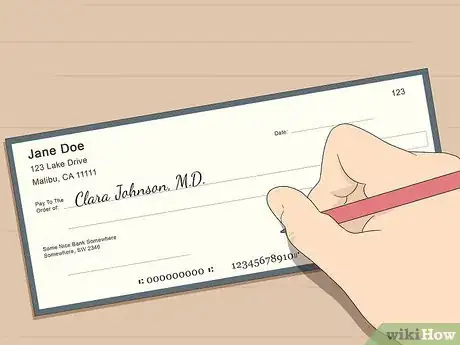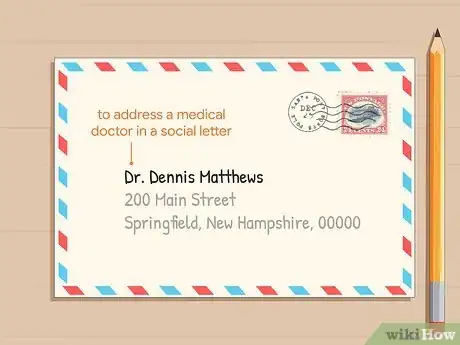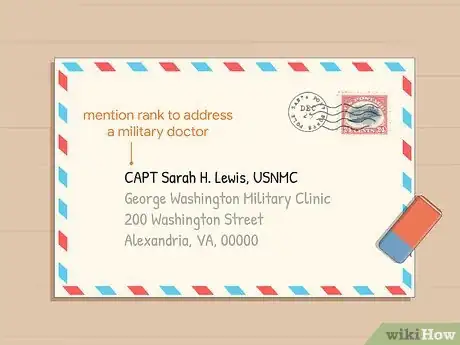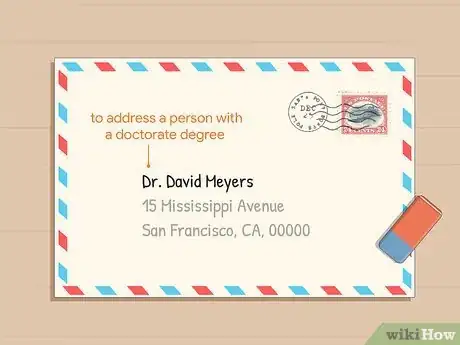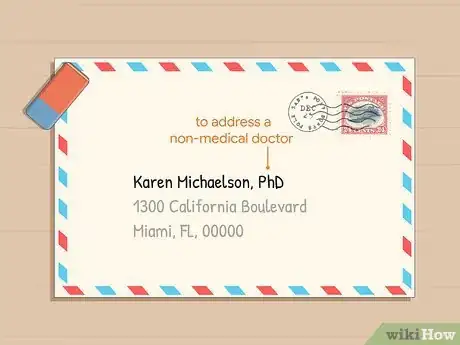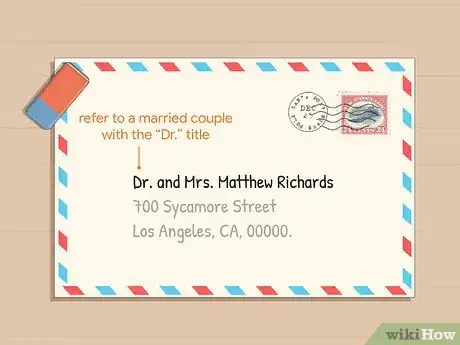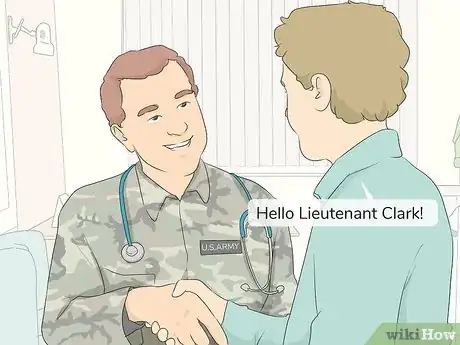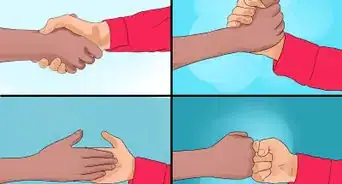This article was co-authored by Tami Claytor and by wikiHow staff writer, Janice Tieperman. Tami Claytor is an Etiquette Coach, Image Consultant, and the Owner of Always Appropriate Image and Etiquette Consulting in New York, New York. With over 20 years of experience, Tami specializes in teaching etiquette classes to individuals, students, companies, and community organizations. Tami has spent decades studying cultures through her extensive travels across five continents and has created cultural diversity workshops to promote social justice and cross-cultural awareness. She holds a BA in Economics with a concentration in International Relations from Clark University. Tami studied at the Ophelia DeVore School of Charm and the Fashion Institute of Technology, where she earned her Image Consultant Certification.
This article has been viewed 49,949 times.
When you’re preparing an invitation, or navigating your way through a conversation, it can be difficult to know how to address a doctor properly. Thankfully, the rules of doctoral etiquette are really easy to suss out. With a little practice and repetition, you’ll be able to put your best foot forward in various social situations!
Steps
Writing Addresses or Invitations
-
1Use “M.D.” when you contact a doctor regarding something medical. Depending on your regular routine, you may be filling out forms, checks, or other official documents that you send to your doctor. Write out their first name and surname, then add an “M.D.” suffix at the end, which notes the formal nature of whatever you’re filling out. When writing something official, only use “M.D.” to address your doctor, and not the “Dr.” prefix.[1]
- For instance, if you were filling out a check, you’d make it out to Clara Johnson, M.D.
-
2Choose “Dr.” when addressing a medical doctor in a social letter. Don’t worry about using both “M.D.” and “Dr.” in social letters, as this is a bit overkill. Instead, address the letter to “Dr.,” then the person’s first name and surname. Complete the rest of the address as you usually would, then you’ll be ready to send out the letter![2]
- For example, if you’re filling out a wedding invitation, you can address it to:
Dr. Dennis Matthews
200 Main Street
Springfield, New Hampshire, 00000
Advertisement - For example, if you’re filling out a wedding invitation, you can address it to:
-
3Include the person’s rank and branch when writing to a military doctor. Think about the specific officer you’re writing to, and what branch of the military they currently serve as doctor in. For official correspondence, figure out which hospital or clinic they’re working at. In the letter header, simply use the individual’s military rank and last name to start off your message.
- For instance, you may address a letter like this:
CAPT Sarah H. Lewis, USNMC
George Washington Military Clinic
200 Washington Street
Alexandria, VA, 00000 - If you’re starting out the letter, you can address it as: “Dear Captain Lewis.”
- For instance, you may address a letter like this:
-
4Use “Dr.” when writing to a person with a doctorate degree. If you’re writing a social letter, like a wedding invitation, you don’t need to use “PhD.” Draft the rest of the address like you usually would, using the person’s first and last name, along with their street, city, and zip code.[3]
- For example, you can address a party invitation like this:
Dr. David Meyers
15 Mississippi Avenue
San Francisco, CA, 00000.
- For example, you can address a party invitation like this:
-
5Opt for “PhD” when addressing a professional letter to a non-medical doctor. Think about the boilerplate of your letter before drafting it out. If you’re writing to a professor or other academic about a recommendation or other official. Use the recipient’s first name and surname, along with the “PhD” suffix on the address portion of the envelope. It’s also best to use this suffix in the letter header, as well.[4]
- For instance, you may address a letter like this:
Karen Michaelson, PhD
1300 California Boulevard
Miami, FL, 00000. - As a letter header, write something like: “Dear Karen Michaelson, PhD,.”
Tip: For something more casual, like an email, look at the doctor’s email signature to see what their preferred title is.[5]
- For instance, you may address a letter like this:
-
6Refer to a married couple with the “Dr.” title. If you’re drafting an invitation or other letter that’s going to a person with a doctorate as well as their spouse, use the “Dr.” prefix and a separate honorific for the individual’s partner. Fill out the rest of the address block as you normally would before sending the letter.[6]
- For example, you can address the letter like this:
Dr. and Mrs. Matthew Richards
700 Sycamore Street
Los Angeles, CA, 00000. - If the wife has a doctorate and the husband does not, address the envelope like this: “Dr. Elizabeth and Mr. Ken Derwin.”
- For example, you can address the letter like this:
Speaking Conversationally
-
1Use “Dr.” when speaking to a physician or someone with a doctorate. If you don’t know the individual well enough to call them by their first name, opt for their prefix and surname instead. Since you’re having a normal conversation, there’s no need to use “M.D.” or “PhD” when you address them.
- For instance, you can say something like: “Good evening Dr. Morgan! How is your night going?”
-
2Address military doctor as “Dr.” You can address a military doctor in the same way that you’d speak to any other medical doctor. Use the “Dr.” prefix along with their surname whenever you speak to them in person.[7]
- For instance, you may say something like: “Good morning Dr. Williams! Would I be able to talk with you about something?”
-
3Opt for military rank if you don’t want to use “Dr.” While you can always use the “Dr.” prefix when speaking with a military doctor, you can always opt for something more efficient. Instead, use the individual’s military rank as a prefix when you speak to them.[8]
- For example, you can say “Hello Lieutenant Clark!” instead of saying “Hello Dr. Clark!”
Community Q&A
-
QuestionHow to address a sibling as a Dr in an obituary?
 Tinty67Community AnswerYou could start with Dr (enter the sibling's name) worked hard to cure/help her/his/their clients/patients. She/he/they was a loving daughter/son and he/she/they was a wonderful mother/father/parent/guardian/aunt/uncle to (name of relative). As well as this, she/he/they was an amazing sibling and I am grieved about her/his/their death.
Tinty67Community AnswerYou could start with Dr (enter the sibling's name) worked hard to cure/help her/his/their clients/patients. She/he/they was a loving daughter/son and he/she/they was a wonderful mother/father/parent/guardian/aunt/uncle to (name of relative). As well as this, she/he/they was an amazing sibling and I am grieved about her/his/their death. -
QuestionHow do you address the mother of a doctor?
 SpaceshipCommunity AnswerRefer to them as Mrs. or Miss if they do not hold a doctoral degree. Ask them what their preference is.
SpaceshipCommunity AnswerRefer to them as Mrs. or Miss if they do not hold a doctoral degree. Ask them what their preference is. -
QuestionHow do you address a husband and wife where the husband is an M.D. and the wife is D.D.S?
 SpaceshipCommunity AnswerAddress the couple as Doctor if they both hold doctorates.
SpaceshipCommunity AnswerAddress the couple as Doctor if they both hold doctorates.
Expert Interview

Thanks for reading our article! If you'd like to learn more about being polite, check out our in-depth interview with Tami Claytor.
References
- ↑ https://www.minotstateu.edu/careers/pages/cover-letter-salutation.shtml
- ↑ https://www.minotstateu.edu/careers/pages/cover-letter-salutation.shtml
- ↑ https://bizfluent.com/how-7906953-address-letter-doctor-education.html
- ↑ https://bizfluent.com/how-7906953-address-letter-doctor-education.html
- ↑ https://www.dailywritingtips.com/how-to-address-your-elders-your-doctor-young-children-and-your-ceo/
- ↑ https://bizfluent.com/how-7906953-address-letter-doctor-education.html
- ↑ https://dcp.psc.gov/ccbulletin/articles/Protocol_04_2009.aspx
- ↑ https://dcp.psc.gov/ccbulletin/articles/Protocol_04_2009.aspx
- ↑ https://bizfluent.com/info-7749962-proper-way-address-lawyer.html
